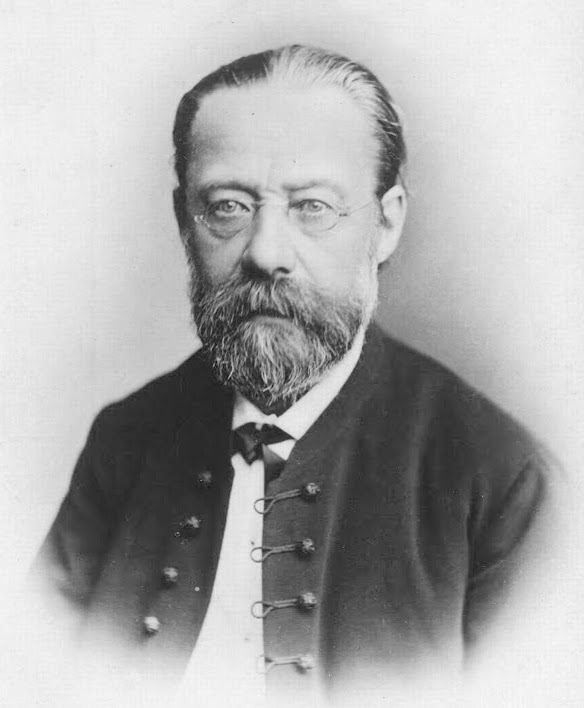
Miliĭ Alekseevich Balakirev
Mily Alexeyevich Balakirev (UK: bə-LA(H)K-i-rev, US: BAH-lah-KEER-ef; Russian: Милий Алексеевич Балакирев, pronounced [ˈmʲilʲɪj ɐlʲɪkˈsʲe(j)ɪvʲɪdʑ bɐˈlakʲɪrʲɪf] (listen); 2 January 1837 [O.S. 21 December 1836] – 29 May [O.S. 16 May] 1910) was a Russian composer, pianist, and conductor known today primarily for his work promoting musical nationalism and his encouragement of more famous Russian composers, notably Pyotr Ilyich Tchaikovsky. He began his career as a pivotal figure, extending the fusion of traditional folk music and experimental classical music practices begun by composer Mikhail Glinka. In the process, Balakirev developed musical patterns that could express overt nationalistic feeling. After a nervous breakdown and consequent sabbatical, he returned to classical music but did not wield the same level of influence as before. In conjunction with critic and fellow nationalist Vladimir Stasov, in the late 1850s and early 1860s, Balakirev brought together the composers now known as The Five (a.k.a., The Mighty Handful) – the others were Alexander Borodin, César Cui, Modest Mussorgsky, and Nikolai Rimsky-Korsakov. For several years, Balakirev was the only professional musician of the group; the others were amateurs limited in musical education. He imparted to them his musical beliefs, which continued to underlie their thinking long after he left the group in 1871, and encouraged their compositional efforts. While his methods could be dictatorial, the results of his influence were several works which established these composers' reputations individually and as a group. He performed a similar function for Tchaikovsky at two points in the latter's career – in 1868–69 with the fantasy-overture Romeo and Juliet, and in 1882–85 with the Manfred Symphony. As a composer, Balakirev finished major works many years after he had started them; he began his First Symphony in 1864 but completed it in 1897. The exception to this was his oriental fantasy Islamey for solo piano, which he composed quickly and remains popular among virtuosos. Often, the musical ideas normally associated with Rimsky-Korsakov or Borodin originated in Balakirev's compositions, which Balakirev played at informal gatherings of The Five. However, his slow pace in completing works for the public deprived him of credit for his inventiveness, and pieces that would have enjoyed success had they been completed in the 1860s and 1870s made a much smaller impact. Balakirev began work on a second symphony, Symphony No. 2 in D minor in 1900, but did not complete the work until 1908. |
Birth and Death Data: Born January 2, 1837 (Nizhny Novgorod), Died May 29, 1910 (Saint Petersburg)
Date Range of DAHR Recordings: 1919 - 1935
Roles Represented in DAHR: composer
 = Recordings are available for online listening.
= Recordings are available for online listening.
 = Recordings were issued from this master. No recordings issued from other masters.
= Recordings were issued from this master. No recordings issued from other masters.
Recordings
| Company | Matrix No. | Size | First Recording Date | Title | Primary Performer | Description | Role | Audio |
|---|---|---|---|---|---|---|---|---|
| Victor | B-23539 | 10-in. | 12/17/1919 | O! Kaip liudna skirtis | Anthony Sodeika | Male vocal solo, with orchestra | composer | |
| Victor | CVE-46449 | 12-in. | 9/3/1928 | Islamey | Eugene Goossens ; Hollywood Bowl Symphony Orchestra | Orchestra | composer | |
| Victor | CVE-46450 | 12-in. | 9/5/1928 | Islamey | Eugene Goossens ; Hollywood Bowl Symphony Orchestra | Orchestra | composer | |
| Victor | BS-89390 | 10-in. | 3/27/1935 | Chanson georgienne | Yolanda Norris | Female vocal solo, with piano | composer |
Citation
Discography of American Historical Recordings, s.v. "Balakirev, Miliĭ Alekseevich," accessed November 22, 2024, https://adpprod2.library.ucsb.edu/names/102048.
Balakirev, Miliĭ Alekseevich. (2024). In Discography of American Historical Recordings. Retrieved November 22, 2024, from https://adpprod2.library.ucsb.edu/names/102048.
"Balakirev, Miliĭ Alekseevich." Discography of American Historical Recordings. UC Santa Barbara Library, 2024. Web. 22 November 2024.
DAHR Persistent Identifier
External Sources
Wikipedia: Милий Алексеевич Балакирев
Discogs: Miliĭ Alekseevich Balakirev
Allmusic: Miliĭ Alekseevich Balakirev
Grove: Miliĭ Alekseevich Balakirev
IMSLP: Miliĭ Alekseevich Balakirev
RISM: Miliĭ Alekseevich Balakirev
IMDb: Miliĭ Alekseevich Balakirev
Britannica: Miliĭ Alekseevich Balakirev
Linked Open Data Sources
LCNAR: Balakirev, Miliĭ Alekseevich, 1837-1910 - http://id.loc.gov/authorities/names/n50041167
Wikidata: Милий Алексеевич Балакирев - http://www.wikidata.org/entity/Q185040
VIAF: http://viaf.org/viaf/61730949
MusicBrainz: Милий Алексеевич Балакирев - https://musicbrainz.org/artist/482dc0a4-0c39-40dc-9d6d-ca250a5ef833
Wikipedia content provided under the terms of the Creative Commons BY-SA license
Feedback
Send the Editors a message about this record.
